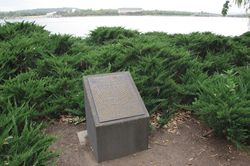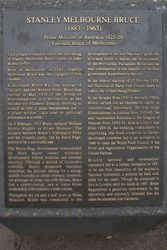
Home » Themes » People » Government - Federal
Lord Stanley Melbourne BrucePrint Page 
The plaque commemorates the scattering of the ashes of Lord Stanley Melbourne Bruce, former Australian Prime Minister.
Lord Stanley Melbourne Bruce (1883-1967) was a barrister before entering Federal Parliament in 1918 as the member for Flinders. He served with distinction in the first World War, being awarded the Military Cross and the Croix de Guerre. He became Prime Minister in 1923 when he was only 39 - Australia’s second youngest prime Minister.
Lord Bruce was serving as Prime Minister when the federal parliament moved to Canberra in 1927. He held office for six and a half years. From 1933 until 1946 he served as Australian High Commissioner to the United Kingdom. In 1947 he was awarded a peerage and became Viscount Bruce of Melbourne.
He served in a number of positions with the United Nations from 1947 to 1951 and as the foundation Chancellor for the Australian National University from 1952 to 1961. He died in London in 1967 and at his request his ashes were scattered in Lake Burley Griffin.
Location
| Address: | Parkes Way, Lake Burley Griffin Foreshore, Commonwealth Park, Parkes, 2600 |
|---|---|
| State: | ACT |
| Area: | AUS |
| GPS Coordinates: | Lat: -35.290455 Long: 149.13737 Note: GPS Coordinates are approximate. |
Details
| Monument Type: | Plaque |
|---|---|
| Monument Theme: | People |
| Sub-Theme: | Government - Federal |
| Link: | https://primeministers.moadoph.gov.… |
Dedication
Stanley Melbourne Bruce
(1883 - 1967)
Prime Minister of Australia 1923 -29
Viscount Bruce of Melbourne
This plaque commemorates the spreading of Stanley Melbourne Bruce's ashes in Lake Burley Griffin.
Born in Melbourne in 1883, Stanley Melbourne Bruce was the youngest of five children. A decorated World War One veteran of Gallipoli and the Western Front, Bruce was elected in May 1918 to the House of Representatives in a by-election as the member for Flinders. Despite referring to himself as only a ' plain businessman and .....a plain soldier', his rise to political prominence was swift.
On 9 February 1923 Bruce replaced William Morris Hughes as Prime Minister. The alliance between Bruce's Nationalist Party and the Country party, led by Earle Page, proved to be a successful one.
The Bruce - Page government concentrated on three major issues : economic development, federal relations and national security. Through a period of economic stabilty, Bruce promoted business enterprise, his policies calling for a strong, unified Australia to attract overseas investors. An advocate of closer ties with Britain, Bruce had a controversial, and at times bitter relationship with Australia's trade unions.
Throughout his six and a half years as Prime Minister, Bruce was committed to the development of the new National Capital. He allocated funds to hasten the development of the Provisional Parliament House and he was instrumental in the transfer of the first governement departments to the city.
In the federal election of 12 October 1929, the Nationalist Party lost fifteen seats to Labor, one of them being Flinders.
In the decades from 1930 to the early 1960s, Bruce carved out an impressive career in international diplomacy. He was High Commissioner in London from 1933 - 45. He also represented Australia in the League of Nations from 1932-39, with a council seat from 1933 - 36. An enduring commitment to improving the food situation in under-developed countries led to an invitation in 1946 to chair the World Food Council of the Food and Agricultrue Organisation of the United Nations.
Bruce`s national and international reputation led to a further invitation in 1951 to be the first chancellor of the Australia National University, a position he held with pride for ten years. Though he continued to live in London until his death in 1967, Bruce bequeathed a generous endowment to the university and expressly directed that his ashes be scattered over Canberra.





